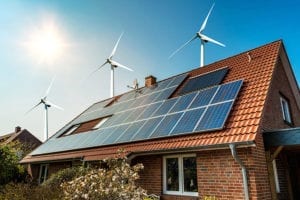
What You Need to Know Before Installing Solar Panels in Cloudy Climates
Installing solar panels is a fantastic way to reduce energy costs and contribute to a more sustainable environment. However, if you live in a region with frequent cloudy weather, you might wonder whether solar energy is a viable option. The good news is that solar panels can still be an excellent investment in cloudy climates. Here’s what you need to know to make the most of solar energy, even under overcast skies.
Solar Panel Efficiency in Cloudy Weather
While it’s true that solar panels perform best in direct sunlight, they don’t stop working on cloudy days. Modern solar panels are designed to capture different spectrums of light, including diffused light on overcast days. Although efficiency does decrease, solar panels can still generate 10-25% of their rated capacity under cloudy conditions. Innovations in photovoltaic technology have also improved the performance of panels in less-than-ideal weather conditions.
Basic Operation
Solar panels consist of photovoltaic (PV) cells that absorb sunlight and convert it into electricity. These cells are made primarily of silicon, which when exposed to light, causes electrons to move freely and generate a flow of electrical current.
Sunlight Requirements
For optimal performance, solar panels require direct sunlight, but they can still function with diffused or indirect light. The intensity of the sunlight directly impacts the amount of energy produced:
- Direct Sunlight: Provides maximum efficiency as PV cells receive full solar irradiance.
- Diffused Light: Even in overcast conditions, solar panels can operate at reduced efficiency, typically between 10% to 25% of their capacity depending on the density of the cloud cover.

Solar Panel Efficiency in Cloudy Weather
Impact of Clouds
Clouds reduce the intensity of sunlight reaching the solar panels. The thicker and denser the cloud cover, the greater the reduction in efficiency. However, it’s crucial to note that modern solar panels are designed to capture a broader spectrum of sunlight, including ultraviolet and infrared light, which penetrates clouds more effectively.
Comparative Efficiency
- Light Clouds: Can allow sufficient light to pass through, reducing efficiency by a smaller margin, generally around 10%-20%.
- Heavy Cloud Cover: Efficiency can drop more significantly, but most panels will still produce about 25% of their maximum output.
How Solar Panels Perform with Limited Sunlight
Solar panels are increasingly designed to be more sensitive to various light wavelengths, which enhances their ability to generate electricity even on cloudy or overcast days. Innovations such as bifacial panels, which capture light from both sides, and advancements in PV cell materials have also helped improve performance in less-than-ideal lighting conditions.
Choosing the Right Type of Solar Panel for Your Climate
When selecting solar panels for your home or business, understanding the climate-specific considerations is crucial. Different climates pose unique challenges and opportunities for solar technology, influencing the efficiency and longevity of the solar panels. Here’s a detailed guide on choosing the most suitable type of solar panel for various climatic conditions and how the right choice can enhance the system’s effectiveness.
Factors Influencing Solar Panel Choice
- Temperature Variability: Solar panels operate in a range of temperatures, but extreme heat can reduce their efficiency. Conversely, certain panels are less effective in colder temperatures but may handle snow load better.
- Sunlight Exposure: Areas with high average annual hours of sunshine may benefit from different types of panels than regions that experience significant cloud cover.
- Inclement Weather: Regions prone to harsh weather conditions, such as hail, hurricanes, or heavy snowfall, require durable panels with robust mounting systems.

Types of Solar Panels and Climate Suitability
1. Monocrystalline Silicon Panels
- Best for: High-temperature areas with consistent sunlight.
- Advantages: These panels are highly efficient in converting sunlight to energy and perform well even in high temperatures, which makes them ideal for sunny regions.
- Considerations: Higher cost, but the investment often pays off in regions with high solar irradiance.
2. Polycrystalline Silicon Panels
- Best for: Moderate climates with balanced temperature profiles.
- Advantages: These panels are less expensive and offer good efficiency under typical weather conditions.
- Considerations: Slightly lower heat tolerance and efficiency compared to monocrystalline panels, which might be a factor in extremely sunny and hot climates.
3. Thin-Film Solar Panels
- Best for: Regions with variable weather conditions, including cloudy and cooler climates.
- Advantages: Thin-film panels are more flexible and perform better in low-light conditions compared to silicon-based options. They can also withstand higher temperatures without significant efficiency loss.
- Considerations: Lower overall efficiency, requiring more installation space for the same electrical output. Good for large, unobstructed areas.
4. Bifacial Solar Panels
- Best for: Areas with significant indirect light and snowy conditions.
- Advantages: These panels capture sunlight from both sides, harnessing reflected light from the ground or snow. This feature increases their overall energy production, especially in areas with high albedo (reflection rate) surfaces.
- Considerations: They require specific mounting and spacing considerations for optimal performance.

How the Right Type Enhances Effectiveness
Choosing the appropriate type of solar panel for your climate not only maximizes the efficiency but also extends the lifespan of your installation:
- Optimized Energy Production: By selecting a panel type that aligns with your local weather patterns and sunlight exposure, you ensure that the system operates at peak efficiency more often.
- Cost Efficiency: Matching the panel type to the climate can reduce maintenance costs and increase the return on investment due to fewer efficiency losses and less wear and tear.
- Sustainability: Efficient use of appropriate technology minimizes the carbon footprint of maintaining and operating solar panels.
Understanding your local climate and its effects on solar panel performance is essential for choosing the right type of solar panel. Whether dealing with high temperatures, frequent cloud cover, or seasonal snow, there are solar panel options designed to maximize efficiency and durability. Properly selected solar technology tailored to specific environmental conditions not only boosts energy production but also ensures greater overall satisfaction with your renewable energy investment.
Financial Incentives and Savings
Investing in solar panels can lead to significant savings on your electricity bills, even in areas with lots of cloud cover. Additionally, many governments offer incentives for solar panel installations, such as tax credits, rebates, and grants. These incentives can substantially reduce the upfront cost of going solar and shorten the payback period of your investment.
It’s also worth considering the potential increase in your home’s value. Homes with solar installations often attract higher resale values than those without. Even in cloudy climates, the appeal of reduced utility bills makes solar-equipped homes more attractive to prospective buyers.
Energy Independence
By installing solar panels, you’re reducing your reliance on traditional power grids and fossil fuels, increasing your energy independence. In cloudy regions, supplementing your solar system with battery storage allows you to store excess power on sunny days, which can then be used during overcast conditions or at night. This setup not only provides a continuous supply of electricity but also enhances your home’s resilience to power outages.

Getting Started with Solar in Cloudy Climates
If you’re considering solar panels for your home in a cloudy climate, here are a few steps to get you started:
- Consult with Professionals: Speak with experienced solar installers who understand the nuances of setting up solar panels in your specific local climate.
- Evaluate Your Energy Needs: Have a professional conduct an energy audit to understand your energy consumption and determine the best system size for your needs.
- Assess Your Roof: Ensure that your roof is suitable for solar installation in terms of structure, orientation, and shading.
- Research Incentives: Look into local and federal incentives that can help reduce the cost of your solar installation.
While solar panels do have optimal performance under direct sunlight, cloudy climates are no longer a significant barrier to enjoying the benefits of solar energy. With the right preparation and technology, installing solar panels can be a rewarding decision that offers environmental benefits, energy savings, and increased property value. Don’t let a few clouds dim your solar aspirations! The future is bright for solar energy, regardless of the weather.


Leave a Reply